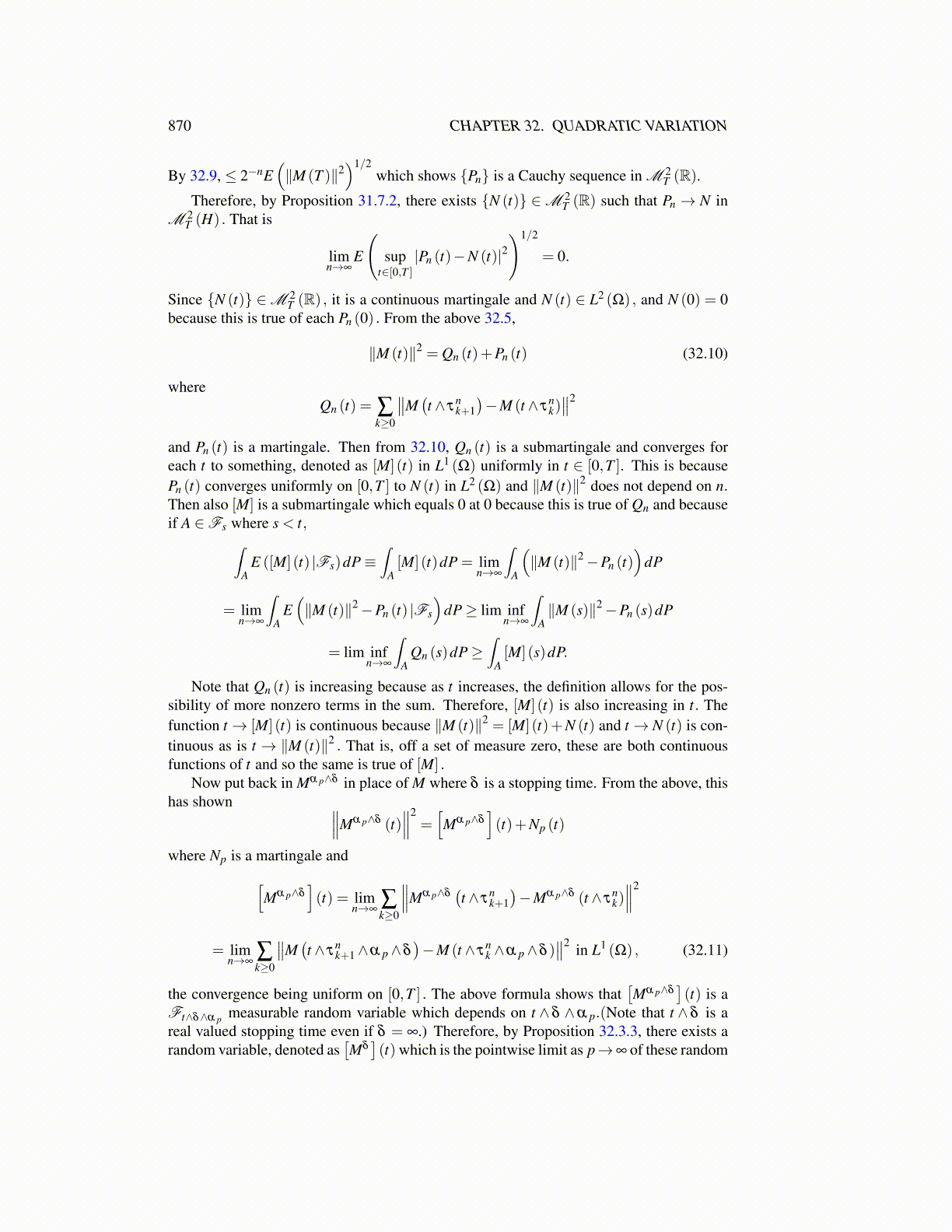
870 CHAPTER 32. QUADRATIC VARIATION
By 32.9, ≤ 2−nE(∥M (T )∥2
)1/2which shows {Pn} is a Cauchy sequence in M 2
T (R).Therefore, by Proposition 31.7.2, there exists {N (t)} ∈M 2
T (R) such that Pn → N inM 2
T (H) . That is
limn→∞
E
(sup
t∈[0,T ]|Pn (t)−N (t)|2
)1/2
= 0.
Since {N (t)} ∈M 2T (R) , it is a continuous martingale and N (t) ∈ L2 (Ω) , and N (0) = 0
because this is true of each Pn (0) . From the above 32.5,
∥M (t)∥2 = Qn (t)+Pn (t) (32.10)
whereQn (t) = ∑
k≥0
∥∥M(t ∧ τ
nk+1)−M (t ∧ τ
nk)∥∥2
and Pn (t) is a martingale. Then from 32.10, Qn (t) is a submartingale and converges foreach t to something, denoted as [M] (t) in L1 (Ω) uniformly in t ∈ [0,T ]. This is becausePn (t) converges uniformly on [0,T ] to N (t) in L2 (Ω) and ∥M (t)∥2 does not depend on n.Then also [M] is a submartingale which equals 0 at 0 because this is true of Qn and becauseif A ∈Fs where s < t,∫
AE ([M] (t) |Fs)dP≡
∫A[M] (t)dP = lim
n→∞
∫A
(∥M (t)∥2−Pn (t)
)dP
= limn→∞
∫A
E(∥M (t)∥2−Pn (t) |Fs
)dP≥ lim inf
n→∞
∫A∥M (s)∥2−Pn (s)dP
= lim infn→∞
∫A
Qn (s)dP≥∫
A[M] (s)dP.
Note that Qn (t) is increasing because as t increases, the definition allows for the pos-sibility of more nonzero terms in the sum. Therefore, [M] (t) is also increasing in t. Thefunction t→ [M] (t) is continuous because ∥M (t)∥2 = [M] (t)+N (t) and t→ N (t) is con-tinuous as is t → ∥M (t)∥2 . That is, off a set of measure zero, these are both continuousfunctions of t and so the same is true of [M] .
Now put back in Mα p∧δ in place of M where δ is a stopping time. From the above, thishas shown ∥∥∥Mα p∧δ (t)
∥∥∥2=[Mα p∧δ
](t)+Np (t)
where Np is a martingale and[Mα p∧δ
](t) = lim
n→∞∑k≥0
∥∥∥Mα p∧δ(t ∧ τ
nk+1)−Mα p∧δ (t ∧ τ
nk)∥∥∥2
= limn→∞
∑k≥0
∥∥M(t ∧ τ
nk+1∧α p∧δ
)−M (t ∧ τ
nk ∧α p∧δ )
∥∥2 in L1 (Ω) , (32.11)
the convergence being uniform on [0,T ] . The above formula shows that[Mα p∧δ
](t) is a
Ft∧δ∧α p measurable random variable which depends on t ∧ δ ∧α p.(Note that t ∧ δ is areal valued stopping time even if δ = ∞.) Therefore, by Proposition 32.3.3, there exists arandom variable, denoted as
[Mδ](t) which is the pointwise limit as p→∞ of these random